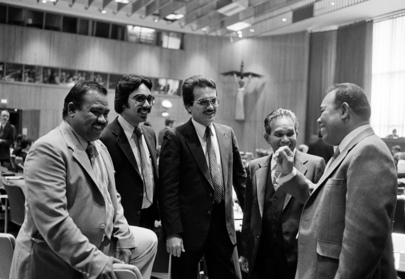
Meet the Trusteeship Council

After a long journey meeting the United Nations Secretariat, General Assembly, Security Council, the Economic and Social Council, and the International Court of Justice, it’s finally time to introduce the sixth and final primary organ of the United Nations: the Trusteeship Council.
“But won’t this be an extraordinarily short blog post?” you ask. After all, the TC suspended operations more than twenty years ago in 1994, one month after Palau (the last Trusteeship territory) gained its independence.
So in one regard, yes. Today, the Trusteeship Council exists in name only and is composed of the five Permanent Members of the Security Council. But, as you might suspect, there’s more to it than that. The history of the body is interesting and it tells us quite a lot about the evolution of the United Nations over time.
World Wars have a destabilizing effect on the international order, and territorial changes are par for the course in peace settlements. In the wake of World War II, it was clear that the dismantling of European empires—decolonization—would be a major feature of the postwar world, but exactly how and when this tectonic shift would occur was up for debate. And the world’s great powers, especially, were wary of it happening too quickly, too violently and too chaotically. In addition to the colonies and territories of Allied victors such as the United States, Great Britain, and France, were League of Nations mandates (which had changed hands after World War I) and territories of the defeated Axis powers, Germany and Japan. Ultimately, eleven territories, seven in Africa and four in Oceania, were placed into the Trusteeship system of the United Nations. Importantly, Palestine was not placed under the Trusteeship Council’s purview when the British mandate ended in 1948.
Originally, the Trusteeship Council was made up of an equal number of administering and non-administering states and included the five permanent members of the Security Council. In 1947 the administering states included Australia, Belgium, Denmark, France, Italy, the Netherlands, New Zealand, Portugal, South Africa, Spain, the United Kingdom and the United States. The non-administering States were elected by the General Assembly. The Trusteeship Council provided supervision and oversight as the Trustee territories worked toward self-governance, achieved independence or joined other neighboring states.
The Trusteeship Council’s work centered on defining a path toward self-governance, independence or joining another sovereign state, often in the midst of intense social, political, and cultural turmoil. The legacy of colonial rule, which often had exacerbated ethnic or religious divisions, continued to plague many of these territories even after the fall of the formal colonial system. The well-known conflict between Hutu and Tutsi groups in Rwanda is but one example of this. As colonial administrations weakened and eventually disappeared, the Trusteeship Council helped oversee elections, quelled violence and provided guidance on good governance.
The list of independent, sovereign states that were once Trust territories or which a Trust territory joined is long and includes Ghana, Somalia, Togo, Cameroon, Nigeria, Tanzania, Rwanda, Burundi, Samoa, Nauru, Papua New Guinea, the Federated States of Micronesia, the Marshall Islands and Palau. The Northern Mariana Islands, once part of the Trust Territory of the Pacific Islands, chose to become a commonwealth in association with the United States in the 1970s. It is now governed as a territory of the United States, marking it as the only Trust territory to not win full independence or fully join another sovereign state.
Because eliminating the Trusteeship Council would require amending the United Nations Charter, such a movement has not gained traction (although eliminating the TC was part of Kofi Annan’s 2005 UN reform recommendations.) There are several other ideas and proposals geared toward reviving the TC’s mandate and scope in light of twenty-first century issues such as governance of the global commons and peacebuilding. After a long renovation process, the chamber of the Trusteeship Council reopened in 2013, and then-Secretary-General Ban Ki-moon suggested the new space would be an important one for the United Nations headquarters in New York. What, exactly, the future holds for the Trusteeship Council remains to be seen.
Keep Up With The Accords
More to read
The AMUN Accords is a premier resource for fact-based Model United Nations simulations. We are always looking for new contributors. Want to write for the AMUN Accords? Check out out the submission guidelines and then get in touch!


